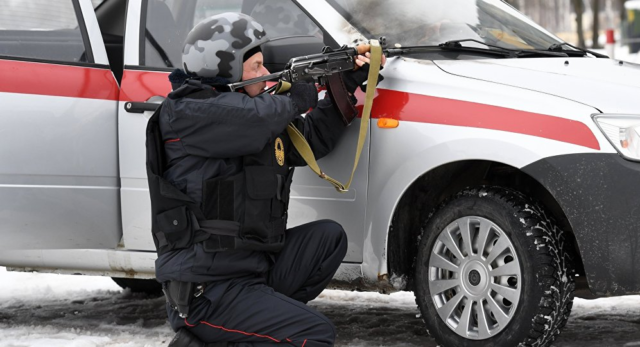
Russians Increasingly Prepared to Use Firearms Against Police
Publication: Eurasia Daily Monitor Volume: 14 Issue: 50
By:

Russians currently own approximately 25 million guns, according to Moscow experts; and while only about 20 percent of these are registered with the authorities as the law requires, most Russian gun owners use their weapons for target practice, hunting or in self-defense (Komsomolskaya Pravda, Windowoneurasia2.blogspot.com, January 17; APN, November 24, 2014). But some of them, it appears, are now prepared to use their weapons against the police, other siloviki (security services personnel) and even members of President Vladimir Putin’s new National Guard. This suggests these gun owners have crossed one of the most serious psychological lines in Russian life. In turn, members of the force structures themselves are going to insist on being more heavily armed and will push for the adoption of new laws to protect them from such attacks. As a result, confrontations between the siloviki and the population could easily become more violent in the coming months and years (Newsru.com, January 10; Windowoneurasia2.blogspot.com, April 1).
At least some of the unregistered weapons Russians possess come from either the anti-terrorist operations in the North Caucasus or from the Russian-occupied Donbas in Ukraine, where control over weapons is far less strict than elsewhere. Russian officials routinely try to link the use of weapons against the police or other force structures to the first while denying there is any link to the latter warzone. But such efforts are disingenuous, not only because there is mounting evidence of the use of weapons against the authorities far from the North Caucasus, but also because some Russian “volunteers” returning from Ukraine have bragged about the weapons they have brought back (Segodnya.ua, September 13, 2015; Windowoneurasia2.blogspot.com, August 3, 2016).
In an article in Nezavisimaya Gazeta last week (April 7), journalists Vladimir Rauvayev and Andrey Serenko report that “the National Guard and police are taking losses” as the result of private individuals using weapons against them. This is a phenomenon neither law enforcement group has had much experience with in the past, and both are concerned about it as a bellwether of their security in the future. On the one hand, they are demanding new laws to prosecute anyone who employs weapons against them; and on the other, they are demanding that they themselves be better armed and protected against such violence from the population (Nezavisimaya Gazeta, April 7).
Rauvayev and Serenko report that in one two-day period, there were two attacks on law enforcement personnel in the southern Russian city of Astrakhan. Officials insisted and the two journalists duly wrote that the attackers were members of a radical Islamist group, noting that the Islamic State took credit for the attacks. These claims may be true, but there are some obvious questions: Astrakhan has not been a hotbed of Islamist activity in the past, and the Russian authorities there and elsewhere have a vested interest in presenting any attacks on the police as being the work of terrorists rather than anyone else. And it is often the case that Russian outlets link the use of guns against people in positions of authority to certain minority ethnic or religious groups—even when they are in no way linked to Islam or Islamist groups.
The most widely covered of these cases involves charges against a man in the Russian Far North who reportedly threatened to shoot representatives of an oil company who were violating the grounds of a sacred lake (Novaya Gazeta, Windowoneurasia2.blogspot.com, May 27, 2016). That case, which has dragged on for more than a year, has been treated as a curiosity in the media. But what has seldom been reported is that the threat of gun violence against those who guard Russia’s national parks and nature preserves has become so severe that those officers now carry guns themselves—something they almost never did in the past (Ecoportal.su, April 7).
Russian police reportedly have stepped up efforts to enforce registration laws. And in some federal subjects, they have even launched weapons “buy back” programs to pluck guns out of private hands lest they be misused. But they appear to be fighting a losing battle: there are now a million more registered guns in Russian than there were only a year or so ago. And if the past ratio of four illegal guns to every legal one holds, that means there are now more than five million guns today than at the end of 2014 (Newsru.com, January 10, 2017; Rossiyskaya Gazeta, June 10, 2016; Windowoneurasia2.blogspot.com, April 1, 2017). At least some of these are going to fall into the hands of criminals, radicals of various kinds, and also those who view the police and other siloviki as enemies to be resisted with violence if necessary.
That being the case, the amount of gun violence directed at the police and other force structure personnel in Russia is likely to rise; and they in turn are likely to be more ready to respond with violence—or even feel justified to use violence pre-emptively. That will certainly make Russian cities and towns more deadly, which will likely provoke calls for more control but also make it more difficult for the authorities to meet such demands.



